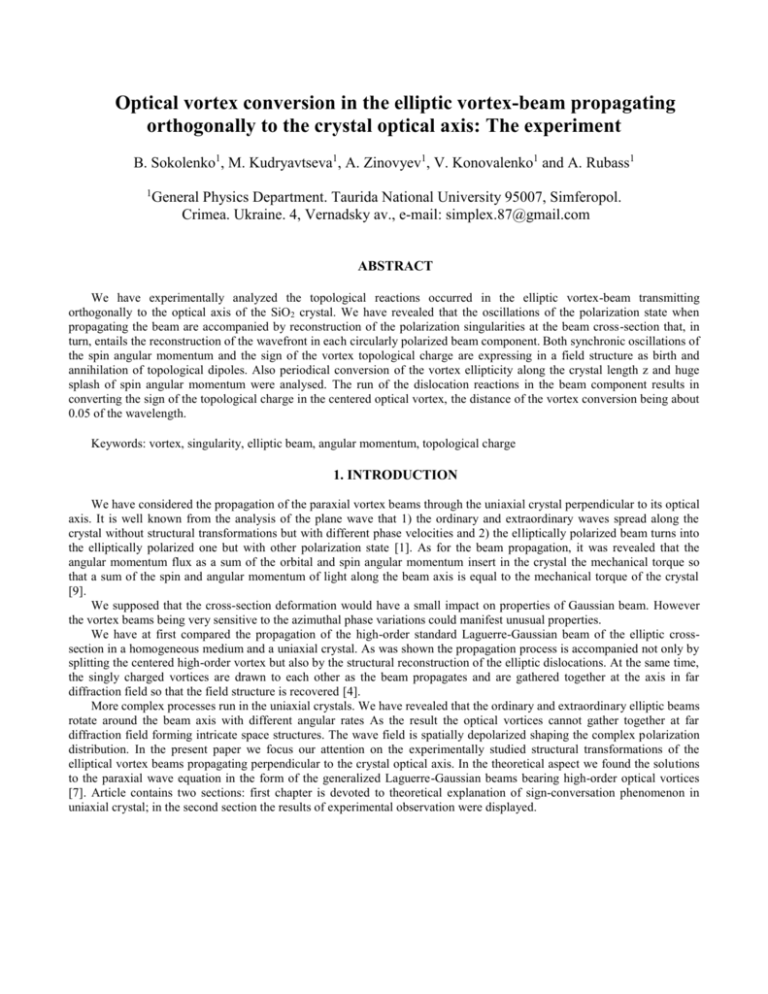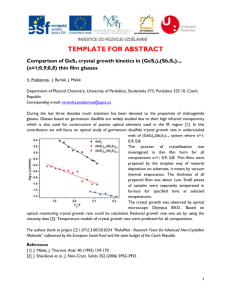Optical vortex conversion in the elliptic vortex
advertisement

Optical vortex conversion in the elliptic vortex-beam propagating orthogonally to the crystal optical axis: The experiment B. Sokolenko1, M. Kudryavtseva1, A. Zinovyev1, V. Konovalenko1 and A. Rubass1 1 General Physics Department. Taurida National University 95007, Simferopol. Crimea. Ukraine. 4, Vernadsky av., e-mail: simplex.87@gmail.com ABSTRACT We have experimentally analyzed the topological reactions occurred in the elliptic vortex-beam transmitting orthogonally to the optical axis of the SiO2 crystal. We have revealed that the oscillations of the polarization state when propagating the beam are accompanied by reconstruction of the polarization singularities at the beam cross-section that, in turn, entails the reconstruction of the wavefront in each circularly polarized beam component. Both synchronic oscillations of the spin angular momentum and the sign of the vortex topological charge are expressing in a field structure as birth and annihilation of topological dipoles. Also periodical conversion of the vortex ellipticity along the crystal length z and huge splash of spin angular momentum were analysed. The run of the dislocation reactions in the beam component results in converting the sign of the topological charge in the centered optical vortex, the distance of the vortex conversion being about 0.05 of the wavelength. Keywords: vortex, singularity, elliptic beam, angular momentum, topological charge 1. INTRODUCTION We have considered the propagation of the paraxial vortex beams through the uniaxial crystal perpendicular to its optical axis. It is well known from the analysis of the plane wave that 1) the ordinary and extraordinary waves spread along the crystal without structural transformations but with different phase velocities and 2) the elliptically polarized beam turns into the elliptically polarized one but with other polarization state [1]. As for the beam propagation, it was revealed that the angular momentum flux as a sum of the orbital and spin angular momentum insert in the crystal the mechanical torque so that a sum of the spin and angular momentum of light along the beam axis is equal to the mechanical torque of the crystal [9]. We supposed that the cross-section deformation would have a small impact on properties of Gaussian beam. However the vortex beams being very sensitive to the azimuthal phase variations could manifest unusual properties. We have at first compared the propagation of the high-order standard Laguerre-Gaussian beam of the elliptic crosssection in a homogeneous medium and a uniaxial crystal. As was shown the propagation process is accompanied not only by splitting the centered high-order vortex but also by the structural reconstruction of the elliptic dislocations. At the same time, the singly charged vortices are drawn to each other as the beam propagates and are gathered together at the axis in far diffraction field so that the field structure is recovered [4]. More complex processes run in the uniaxial crystals. We have revealed that the ordinary and extraordinary elliptic beams rotate around the beam axis with different angular rates As the result the optical vortices cannot gather together at far diffraction field forming intricate space structures. The wave field is spatially depolarized shaping the complex polarization distribution. In the present paper we focus our attention on the experimentally studied structural transformations of the elliptical vortex beams propagating perpendicular to the crystal optical axis. In the theoretical aspect we found the solutions to the paraxial wave equation in the form of the generalized Laguerre-Gaussian beams bearing high-order optical vortices [7]. Article contains two sections: first chapter is devoted to theoretical explanation of sign-conversation phenomenon in uniaxial crystal; in the second section the results of experimental observation were displayed. 2. THEORETICAL MODEL OF ELLIPTICAL BEAM PROPAGATION IN ANISOTROPIC MEDIA A Gaussian beam transmitting perpendicular to the crystal optical axis is split into two beams: the ordinary beam and the extraordinary beam. The ordinary beam propagates along the uniaxial crystal similar to its propagation along a homogeneous medium. However, the extraordinary Gaussian beam experiences anisotropic diffraction and its cross-section is elliptically deformed [4]. Let’s consider the propagation paraxial vortex beams through the uniaxial crystal perpendicular to its optical axis. On the other hand, it is well known that astigmatic transformations (in particular, an elliptic deformation) of singular beams in free space or a homogeneous medium can significantly change the structure of optical vortices embedded in the beams because of the strong sensitivity of the beam phase to weak variations of the beam shape. y E extr n1, n2 Eout Ein x z y Eordin wу x wx Fig.1 Sketch of elliptic vortex-beam propagating thought anisotropic media: Gray-colored elliptic shapes – for the initial ordinary beam; Dark – colored ones - for extraordinary beam component Naturally, variations of the anisotropic medium parameters will create drastic amendments in the picture of vortex-beam propagation. It is known that circularly polarized singular beam with elliptical cross-section feels some transformation of polarization state while propagation in anisotropic media such as uniaxial crystal. It is caused by different scales of refractive indices along the x- and y- axes for the extraordinary beams in the crystal [3]. Now, we consider briefly aftermath of inhomogeneity of the polarization state over the beam elliptic cross-section and a beam perturbation along the y-axis on the example of the low-order vortex-beam (see Fig.1). Our question is does the centered vortex change the sign of its topological charge when transmitting? To describe this process we rewrite the electric field of the E and E components near the beam axis. E1,0 A x y x y 1,0 i a B A i a B , E wx wy wx wy , (1) where A where xx 1 i z / z xx , xy ei x z i y z i z ei x z e y , , B a xy xx xy yy yx yy xx xx xy yx yx yy 2 1 i z / z xy , yx 1 i z / z yx , yy 1 i z / z yy , zxx kx wx / 2, z yx kx wy2 / 2 , e z yx k y wx2 / 2, z yy k x2 / k y w2y / 2 The parameter a in eq. (2) adjusts the initial vortex core shape at the z=0 plane. It is an independent parameter that can be inserted into the solutions (1) and (2) as the amplitude factor. (2) 3. CONCLUSION We have experimentally analyzed the topological reactions occurred in the elliptic vortex-beam transmitting orthogonally to the optical axis of the SiO2 crystal. The beam propagation perpendicular to the crystal optical axis breaks the former symmetry. Naturally, the vortex conversion in this case results in transforming the orbital angular momentum. But now three processes take part in the phenomenon. The spin and orbital angular momentum are supplemented by the response of the crystal medium. It is the sum of these three processes that must reduce to conservation of the total angular momentum. REFERENCES [1]. Born M. and Wolf E., [Principles of Optics], Pergamon, New York, (1975). [2]. Ciattoni A., Palma C. , “Optical propagation in uniaxial crystals orthogonal to the optical axis: paraxial theory and beyond,” J. Opt. Soc. Am. A 20, 2163-2171 (2003). [3]. Soskin M.S., Vasnetsov M.V. , “Singular optics”. Progress in Optics, 42, 219-276, (2001). [4]. Fadeyeva T. A., Rubass A. F., Sokolenko B. V., Volyar A V., “The vortex-beam “precession” in a rotating uniaxial crystal”, J. Opt. A: Pure Appl. Opt., 11, 094008.1-094008.8, (2009). [5]. Egorov Yu.A., Fadeyeva T.A., Volyar A.V. , “The fine structure of singular beams in crystals: colours and polarization” J. Opt. A: Pure Appl. Opt., V.6. P.S217–S228, (2004). [6]. Fadeyeva T.A. , Volyar A.V. , “Extreme spin-orbit coupling in crystal-traveling paraxial beams”, J. Opt. Soc. Am. A., Vol. 27, No. 3. P.381-389, (2010). [7]. Fadeyeva T.A., Rubass A.F., Volyar A.V. , “Transverse shift of a high-order paraxial vortex-beam induced by a homogeneous anisotropic medium”, Physical Review A., V. 79, № 5, 053815-1-12, (2009). [8]. Fadeyeva T., Alexeyev C., Sokolenko B., Kudryavtseva M., Volyar A. ,”Non-canonical propagation of high-order elliptic vortex beams in a uniaxially anisotropic medium”, Ukrainian Journal of Physical Optics. 12 62-82, (2011). [9]. Allen L., Barnett S., Padgett M. [Optical angular momentum], Institute of Physics Pub., - Science - 300 pages (2003). [10]. Nye J. F. [Natural focusing and fine structure of light: caustics and wave dislocations], Institute of Physics Pub., Science – 328, (1999). [11]. Toyoda T., Yabe M. , M “The temperature dependence of the refractive indices of fused silica and crystal quartz”, J. Phys. D: Appl., 16 L97, (1983).








